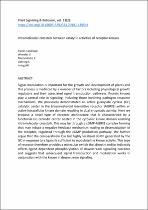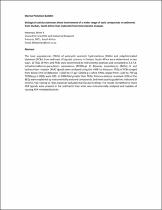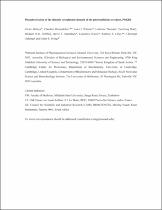JavaScript is disabled for your browser. Some features of this site may not work without it.
- ResearchSpace
- →
- Research Publications/Outputs
- →
- Journal Articles
- →
- View Item
| dc.contributor.author |
Kwezi, Lusisizwe

|
|
| dc.contributor.author |
Wheeler, JI

|
|
| dc.contributor.author |
Marondedze, C

|
|
| dc.contributor.author |
Gehring, C

|
|
| dc.contributor.author |
Irving, HR

|
|
| dc.date.accessioned | 2018-09-06T13:06:45Z | |
| dc.date.available | 2018-09-06T13:06:45Z | |
| dc.date.issued | 2018-02 | |
| dc.identifier.citation | Kwezi, L. et al. 2018. Intramolecular crosstalk between catalytic activities of receptor kinases. Plant Signaling & Behavior, vol. 13(2): https://doi.org/10.1080/15592324.2018.1430544 | en_US |
| dc.identifier.issn | 1559-2324 | |
| dc.identifier.issn | 1559-2316 | |
| dc.identifier.uri | https://doi.org/10.1080/15592324.2018.1430544 | |
| dc.identifier.uri | https://www.tandfonline.com/doi/full/10.1080/15592324.2018.1430544 | |
| dc.identifier.uri | http://hdl.handle.net/10204/10400 | |
| dc.description | Copyright: 2018 Taylor & Francis. Due to copyright restrictions, the attached PDF file only contains the abstract of the full text item. For access to the full text item, please consult the publisher's website. | en_US |
| dc.description.abstract | Signal modulation is important for the growth and development of plants and this process is mediated by a number of factors including physiological growth regulators and their associated signal transduction pathways. Protein kinases play a central role in signaling, including those involving pathogen response mechanisms. We previously demonstrated an active guanylate cyclase (GC) catalytic center in the brassinosteroid insensitive receptor (AtBRI1) within an active intracellular kinase domain resulting in dual enzymatic activity. Here we propose a novel type of receptor architecture that is characterized by a functional GC catalytic center nested in the cytosolic kinase domain enabling intramolecular crosstalk. This may be through a cGMP-AtBRI1 complex forming that may induce a negative feedback mechanism leading to desensitisation of the receptor, regulated through the cGMP production pathway. We further argue that the comparatively low but highly localized cGMP generated by the GC in response to a ligand is sufficient to modulate the kinase activity. This type of receptor therefore provides a molecular switch that directly and/or indirectly affects ligand dependent phosphorylation of downstream signaling cascades and suggests that subsequent signal transduction and modulation works in conjunction with the kinase in downstream signaling. | en_US |
| dc.language.iso | en | en_US |
| dc.publisher | Taylor & Francis | en_US |
| dc.relation.ispartofseries | Worklist;21263 | |
| dc.subject | Auto-regulation | en_US |
| dc.subject | brassinosteroid receptor (BRI1) | en_US |
| dc.subject | cyclic GMP | en_US |
| dc.subject | intramolecular crosstalk | en_US |
| dc.subject | phytosulfokine receptor 1 (PSKR1) | en_US |
| dc.subject | PeP1 receptor (PEPR1) | en_US |
| dc.subject | phosphorylation | en_US |
| dc.subject | receptor kinase | en_US |
| dc.subject | signal transduction | en_US |
| dc.title | Intramolecular crosstalk between catalytic activities of receptor kinases | en_US |
| dc.type | Article | en_US |
| dc.identifier.apacitation | Kwezi, L., Wheeler, J., Marondedze, C., Gehring, C., & Irving, H. (2018). Intramolecular crosstalk between catalytic activities of receptor kinases. http://hdl.handle.net/10204/10400 | en_ZA |
| dc.identifier.chicagocitation | Kwezi, Lusisizwe, JI Wheeler, C Marondedze, C Gehring, and HR Irving "Intramolecular crosstalk between catalytic activities of receptor kinases." (2018) http://hdl.handle.net/10204/10400 | en_ZA |
| dc.identifier.vancouvercitation | Kwezi L, Wheeler J, Marondedze C, Gehring C, Irving H. Intramolecular crosstalk between catalytic activities of receptor kinases. 2018; http://hdl.handle.net/10204/10400. | en_ZA |
| dc.identifier.ris | TY - Article AU - Kwezi, Lusisizwe AU - Wheeler, JI AU - Marondedze, C AU - Gehring, C AU - Irving, HR AB - Signal modulation is important for the growth and development of plants and this process is mediated by a number of factors including physiological growth regulators and their associated signal transduction pathways. Protein kinases play a central role in signaling, including those involving pathogen response mechanisms. We previously demonstrated an active guanylate cyclase (GC) catalytic center in the brassinosteroid insensitive receptor (AtBRI1) within an active intracellular kinase domain resulting in dual enzymatic activity. Here we propose a novel type of receptor architecture that is characterized by a functional GC catalytic center nested in the cytosolic kinase domain enabling intramolecular crosstalk. This may be through a cGMP-AtBRI1 complex forming that may induce a negative feedback mechanism leading to desensitisation of the receptor, regulated through the cGMP production pathway. We further argue that the comparatively low but highly localized cGMP generated by the GC in response to a ligand is sufficient to modulate the kinase activity. This type of receptor therefore provides a molecular switch that directly and/or indirectly affects ligand dependent phosphorylation of downstream signaling cascades and suggests that subsequent signal transduction and modulation works in conjunction with the kinase in downstream signaling. DA - 2018-02 DB - ResearchSpace DP - CSIR KW - Auto-regulation KW - brassinosteroid receptor (BRI1) KW - cyclic GMP KW - intramolecular crosstalk KW - phytosulfokine receptor 1 (PSKR1) KW - PeP1 receptor (PEPR1) KW - phosphorylation KW - receptor kinase KW - signal transduction LK - https://researchspace.csir.co.za PY - 2018 SM - 1559-2324 SM - 1559-2316 T1 - Intramolecular crosstalk between catalytic activities of receptor kinases TI - Intramolecular crosstalk between catalytic activities of receptor kinases UR - http://hdl.handle.net/10204/10400 ER - | en_ZA |









